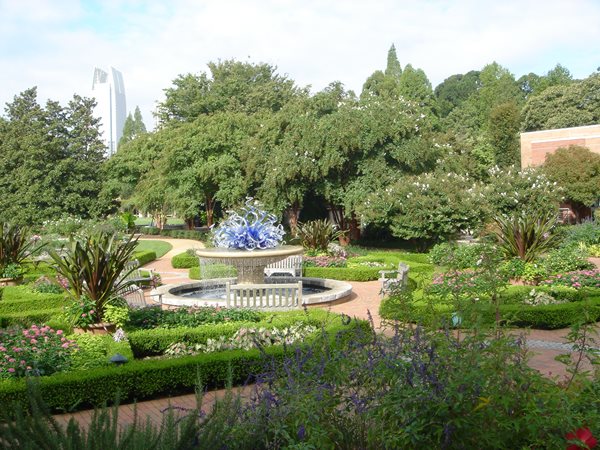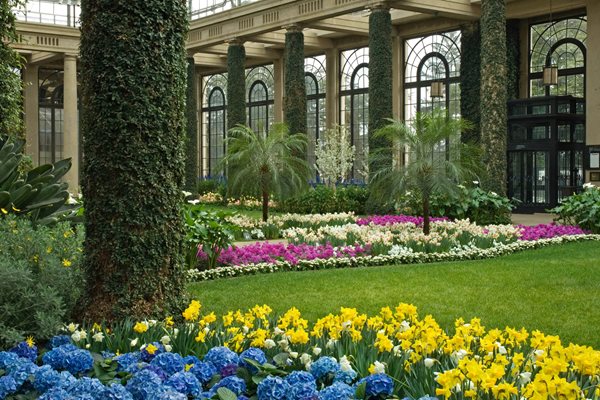National Public Gardens
The United States has more than 500 public gardens. Visit one on May 7 — National Public Garden Day.
By Mark Havenner

Photo by: Courtesy Atlanta Botanical Garden
National Public Gardens Day, now in its second year, is on May 7 and is a day for the public to celebrate their local botanical gardens and arboreta. Over 500 gardens are participating and are offering a variety of events, tours, and special offers throughout the day and through Mother’s Day weekend. National Public Gardens Day was developed in partnership with the American Public Gardens Association and Rain Bird.
Atlanta Botanical Garden, Atlanta, Ga.: Awarded the Atlanta Urban Design Commission Award of Excellence for Landscape Design in 2003, the Levy Parterre's formal, boxwood-edged beds are arranged symmetrically around an Italian limestone fountain featuring artist Dale Chihuly's dazzling blue and white glass sculpture, dramatically poised above the water.

Photo by: Courtesy Denver Botanic Gardens
Denver Botanic Gardens, Denver, Co.:The Japanese Tea Garden is planted with Ponderosa pine (Pinus ponderosa) from Roosevelt National Forest (pine signify longevity and happiness in Japanese gardens). The authentic teahouse was shipped across the Pacific from Japan and reassembled by skilled Japanese artisans.

Photo by: Courtesy Denver Botanic Gardens
Denver Botanic Gardens, Denver, Co.: The Water Smart Garden includes plants from semi-arid climates of the West and other areas of the world that have a similar climate to Colorado’s, including the Mediterranean, South Africa, South America and Central Asia.

Photo by: Courtesy Desert Botanical Garden
Desert Botanical Garden, Phoenix, Az.: The new Ottosen Entry Garden has become the grand lobby of the Desert Botanical Garden, announcing to visitors that they have arrived at a unique and exciting Southwest destination.

Photo by: Courtesy Desert Botanical Garden

Photo by: Courtesy Descano Gardens
Descano Gardens, La Canada Flintridge, Ca.: A forest of coastal oaks.

Photo by: Courtesy Descano Gardens
Descano Gardens, La Canada Flintridge, Ca.: A forest of coastal oaks.

Photo by: Courtesy The Huntington Botanical Gardens
The Huntington Botanical Gardens, San Marino, Ca.: The Huntington Desert Garden is one of the largest and oldest assemblages of cacti and other succulents in the world. The two dozen families of succulents and other arid adapted plants have developed into a 10-acre garden display, the Huntington’s most important conservation collection.

Photo by: Courtesy The Huntington Botanical Gardens
The Huntington Botanical Gardens, San Marino, Ca.: Occupying nine acres on the slopes of a canyon, this is one of America’s oldest, most elaborate, and gracefully matured Japanese gardens. The garden boasts several beautiful forms of Japanese red pine, handsome spreading junipers, large cycads, arbors of wisteria, and thirty-foot-high sweet olives.

Photo by: Courtesy The Huntington Botanical Gardens
The Huntington Botanical Gardens, San Marino, Ca.: The solution to an unsightly gully in the southeast corner of the gardens, the four acres that make up the lily ponds were a perfect place to build two large and three small ponds. The pond water, which is circulated and recycled, is home to turtles, bullfrogs, Japanese koi, aquatic plants, and an occasional mallard family.

Photo by: Courtesy The Huntington Botanical Gardens
The Huntington Botanical Gardens, San Marino, Ca.: Constructed of Colorado Yule marble, the mausoleum of Henry and Arabella Huntington overlooks the gardens from a knoll in the middle of the orange groves. Huntington selected John Russell Pope, one of America’s most distinguished architects, to design the mausoleum in the form of a Greek temple. Pope believed the classic circular peristyle (or double colonnade) and dome were well suited to the nature of the Huntington grounds because it presented a perfect front from every angle, and was a combination of two perfect forms, the circle and sphere.

Photo by: Courtesy Longwood Gardens
Longwood Gardens, Kennett Square, Pa.: The plantings bordering the 600-foot-long brick walk are a mixture of annual and perennial flowers, spring bulbs, woody shrubs and ornamental grasses. Notables include panicle hydrangea (Hydrangea paniculata 'Unique'), rosemary willow (Salix elaeagnos) and purple smoke-tree (Cotinus coggygria 'Velvet Cloak'). A semi-circular stone "whispering bench" ends the walk.

Photo by: Courtesy Longwood Gardens
Longwood Gardens, Kennett Square, Pa.: This spectacular five-acre fountain garden combines French and Italian design elements with American electrical technology. When the full display is running, 10,000 gallons of water recirculate each minute through 380 fountainheads, scuppers and spouts. The garden is surrounded by Norway maples that are pruned every winter into a giant cubed hedge.

Photo by: Courtesy Longwood Gardens
Longwood Gardens, Kennett Square, Pa.: Longwood's Conservatory is one of the world's great greenhouse structures. It shelters 20 indoor gardens and 5,500 types of plants. The Conservatory was built in 1919 and at present there are 195,668 square feet—or 4.5 acres—of covered display, production, and research greenhouses.

Photo by: Courtesy The Morris Arboretum of the University of Pennsylvania
The Morris Arboretum of the University of Pennsylvania, Philadelphia, Pa.: The Swan Pond was designed and installed in 1905 by John Morris. This artificial lake was created by damming the East Brook, which naturally flows through the Arboretum.

Photo by: Courtesy The Morris Arboretum of the University of Pennsylvania
The Morris Arboretum of the University of Pennsylvania, Philadelphia, Pa.: Built in 1905 by Mr. Muto, the Japanese Hill and Water Garden (or Tsukiyama-niwa) was made from soil dug out of the Swan Pond. Hills, rocks, water, trees, bridges, paths, shrines and lanterns were arranged according to certain rules of Tsukiyama-niwa to create an image of nature.

Photo by: Courtesy The Morris Arboretum of the University of Pennsylvania
The Morris Arboretum of the University of Pennsylvania, Philadelphia, Pa.: The Cottage Garden is located on the southeast side of the Rose Garden and contains a wide variety of old fashioned roses, perennials, and annuals.

Photo by: Courtesy The Morris Arboretum of the University of Pennsylvania
The Morris Arboretum of the University of Pennsylvania, Philadelphia, Pa.: Planted in the popular cottage garden style, this overflowing mix of plants is a treat for the senses. Muted pastel colors relax the eye while a variety of roses and perennials entice the nose with captivating scent. Many of the roses bloom only in early June, but this garden has something to offer the visitor all summer long.

Photo by: Courtesy Smithsonian Museum of Natural History
Enid A. Haupt Garden, The Smithsonian Museum of Natural History, Washington, DC: While wandering the brick paths of this public garden in the Smithsonian complex and admiring the parterre and hanging baskets, or splashing in the fountains, few visitors realize that they are standing on the roofs of the National Museum of African Art, the Arthur M. Sackler Gallery, and the S. Dillon Ripley Center (International Gallery).

Photo by: Courtesy The United States Botanic Garden
The United States Botanic Garden, Washington, DC: The beds in the Park, created in 1932, were geometrically arranged and planted in formal classical style to feature the Bartholdi Fountain and accommodate public gatherings. The plantings are now continuously updated to reflect modern trends in American horticulture and new plant introductions.

Photo by: Courtesy The United States Botanic Garden
United States Botanic Garden, Washington, DC: The First Ladies' Water Garden was designed to create a memorable image of the central role that water plays in the well-being of plants, animals, and humankind. The Water Garden honors the First Ladies of the United States by recognizing their notable service to our country.

Photo by: Courtesy The United States Botanic Garden
The United States Botanic Garden, Washington, DC: The major features of the National Garden are the Rose Garden, the Butterfly Garden, the Lawn Terrace, the First Ladies' Water Garden, the Regional Garden, and an outdoor amphitheater (pictured).

Photo by: Courtesy The United States Botanic Garden
The United States Botanic Garden, Washington, DC: The $10 million National Garden project was funded privately via The National Fund for the U.S. Botanic Garden (USBG), a not-for-profit corporation.

Photo by: Courtesy The United States Botanic Garden
The United States Botanic Garden, Washington, DC: The garden opened to the public in October 2006 and provides "living laboratories" for environmental, horticultural, and botanical education in a contemplative setting.




